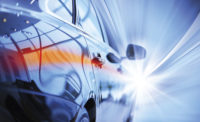Appearance Characteristics
Color variety is almost limitless these days, with many coatings suppliers offering a pallet of off-the-shelf colors, as well as custom color-match services to better meet the needs of small-volume powder users.There are also tints that can add highlight color to a substrate or base coat, such as a brass look over polished aluminum.
A range from flat to high gloss is generally available. Smooth, high-gloss coatings can offer high distinctiveness of image, creating an illusion of depth or a wet look. Matte finishes can hide surface defects or imperfections such as spot welds, nicks and scratches on a variety of substrates.
Following are some of the newest innovations in powder coatings.
Multi-Color
Hammertones or veins result in antique or distressed looks created by a black base with metallic pigments of gold, silver, or copper contrasting against the black. This weathered look is popular in the furniture and display industries, which demand a range of multi-color looks including granite, confetti, rusty, and weathered appearances.Clearcoats
Clear powders are often used as an external protective layer on many brass products such as door knobs, hinges, railings, lamps and plumbing fixtures. There are also powders available that can substitute for chrome and brass plating in certain applications. Auto manufacturers such as BMW and Volvo are now using powder clearcoats over automotive exterior basecoats, a technology that is also being tested in a historic collaboration of Ford, General Motors and DaimlerChrysler at a facility in Wixom, MI.Fluorescent/Pearl-Like
Powder coated finishes can now offer an icy or fluorescent appearance, or the lustrous look of a pearl that may appear to change color depending on the angle of observation. Bicycles, wheel rims, garden tools, light fixtures and some glass products benefit from this look.Photoluminescent
Photoluminescent powder coatings are able to absorb ultraviolet, fluorescent, or incandescent light, and gradually re-emit the light. These are often available in blue, yellow and green, and are used for road signs, hazard warnings, and markings on trucks, buses, and police cars.Metallics
Metallic coatings add sparkle highlights, which can reproduce the appearance of the base metal and add richness to the look of the product. A variety of metallic finishes have been formulated for indoor and outdoor furniture, exercise equipment, lawn and garden tools, and other products, that can resemble the look of gold, chrome, or brass.Textures
Textured coatings are often used to hide substrate irregularities and fingerprints, which may show with a smooth finish. It provides a nonslip surface while giving a distinctive feel to a product. Appearances vary from the look of fine sandpaper, a pebbly texture, or a rougher look resembling alligator skin.Wrinkles
Wrinkle finishes are a special class of textures that offer styling variation and a consistent appearance. They exhibit excellent resistance to high wear and weatherability conditions seen with tools, exercise equipment, and shop displays.Performance Characteristics
Many new performance characteristics are available in today’s coatings, from antibacterial properties to the ability to be cured by ultraviolet or even near-infrared radiation.Advanced Durability
Recent research and testing has developed specially formulated polyester powders that provide even greater weatherability than achievable in previous years, and showing greater success in long-term Florida exposure testing. New TGIC-based powders are being used on outdoor stadium seating and other exterior applications that were previously susceptible to degradation from ultraviolet rays. Light poles, lawn furniture, shopping carts and shelving often benefit from powder with polytetrafluoroethylene (Teflon) additives for increased resistance to abrasion.Electroconductive and Electrodissipative
Makers of electronic components sometimes use electroconductive and electrodissipative powder coatings, which provide electrostatic discharge protection of the components, critical during the manufacture, testing, and transport of electronic goods. The most common colors for these special powders are black and charcoal, but lighter colors are also available.Heat-Sensitive Substrates
In recent years, ongoing research and development has been devoted to formulating powders that can cure at low temperatures, below 212ºF, without compromising durability or quality. These powders can be used on temperature-sensitive materials, as well as on massive parts that require enormous amounts of energy with other curing systems. Wood materials such as particle board and fiberboard, as well as glass and plastic products, can now benefit from a powder coated finish — products that would deform or emit VOCs at higher cure rates. This technology has helped to penetrate markets for office furniture, kitchen cabinets, and ready-to-assemble furniture for homeowners. Preassembled components such as electrical motors, shock absorbers, foam-core doors, and other products that may have plastics, laminations, electrical wires, or rubber seals, can also receive a powder coated finish. In addition, heat-sensitive alloys such as magnesium can be powder coated.


Report Abusive Comment